Paradise fish
| Paradise fish | |
|---|---|

| |
| Macropodus opercularis male | |
| Scientific classification | |
| Domain: | Eukaryota |
| Kingdom: | Animalia |
| Phylum: | Chordata |
| Class: | Actinopterygii |
| Order: | Anabantiformes |
| Family: | Osphronemidae |
| Genus: | Macropodus |
| Species: | M. opercularis
|
| Binomial name | |
| Macropodus opercularis | |

| |
| Synonyms[2] | |
The fork tailed paradisefish (often just called paradise fish, paradise-fish, paradisefish), or paradise gourami (Macropodus opercularis) is a species of
Behaviour

Paradise fish are fairly combative, harassing and attacking each other, as well as potentially assaulting and killing small fish. During a fight, the paradise fish will often change its color, usually displaying dark blue lateral lines on the sides of their bodies; extend its fins; and spread out its
Habitat and diet
Paradise fish are tolerant of a wide range of water conditions, surviving in cool and warm waters alike. In the wild, they are most commonly found in shallow water containing dense vegetation, such as a marsh or rice field.[8] However they can be kept in outdoor ponds, or even the simplest of unheated aquaria. They will accept virtually any food, but should be given a reasonably high-protein diet (as opposed to vegetable-based foods.) They also eat mosquito larvae, black worms, brine shrimp, and small flies.
Disease control
In Taiwan, the native populations of paradise fish have been reduced to low levels by pollution in the rivers, and are now listed as a threatened species. The local population of yellow fever mosquitoes (Aedes aegypti) has since increased in the absence of one of its main predators. The infection rate for dengue fever has subsequently increased in the human population, caused in part by to the lack of natural mosquito predators.[citation needed]
Paradise fish are also considered to be an ideal subject for behavioral genetic studies and have been used to study Iridoviridae type viruses.[9]
In home aquaria

Male paradise fish should be kept apart, since they will fight aggressively by locking jaws. A male can be kept with females; females may also be kept together in groups. A tank that includes paradise fish should be at least 20 US gallons (76 L; 17 imp gal) in size for a single male or 20–30 US gallons (76–114 L; 17–25 imp gal) for a community tank. The tank should be well planted[3] and covered; bogwood and rockwork may be included.
Paradise fish tankmates must be chosen with care. Suitable ones include
may also be victimized due to their resemblance to paradise fish. Male paradise fish may also attempt to court female bettas and gouramis.Fish less than 1.8 centimetres (11⁄16 in)[citation needed] are likely to be consumed violently. If kept with significantly larger but non-aggressive fish, such as Geophagus cichlids, large Synodontis catfishes, or larger gouramis, they are usually submissive and do not act nearly as abusively as when they are the dominant species in the aquarium. However, they themselves can be bullied by similar sized or even smaller fish if that fish has already established territory in the tank which it is not willing to share or give up. If this is the case they will not even attempt to fight and will take to hiding behind filters, plants, or in décor, and will succumb to stress eating and diarrhoea.
Reproduction

As is typical of most bettas and gouramis,
An albino form of Macropodus opercularis is available. Many aquarists consider this form to be less aggressive than the wild type, but also less hardy, having more trouble with low temperatures.
References
- . Retrieved 19 November 2021.
- ^ a b Froese, Rainer; Pauly, Daniel (eds.) (2019). "Macropodus opercularis" in FishBase. August 2019 version.
- ^ ISBN 978-0-2413-6424-6.
- ISBN 978-0-7641-3715-0.
- ^ Bischof, Claudia. "Diversity In Agonistic Behavior Of Croaking Gouramis (Trichopsis Vittata, T. Schalleri, And T. Pumila; Anabantoidei) And The Paradise Fish (Macropodus Opercularis; Anabantoidei)." Aggressive Behavior 22.6 (1996): 447–455. Academic Search Complete. Web. 19 Feb. 2015.
- ^ Gerlai, Robert, and Jerry A. Hogan. "Learning To Find The Opponent: An Ethological Analysis Of The Behavior Of Paradise Fish (Macropodus Opercularis) In Intra- And Interspecific Encounters." Journal of Comparative Psychology 106.3 (1992): 306–315. PsycARTICLES. Web. 19 Feb. 2015.
- ^ Warren, J. M. "Reversal Learning By Paradise Fish (Macropodus Opercularis)." Journal of Comparative and Physiological Psychology 53.4 (1960): 376–378. PsycARTICLES. Web. 20 Feb. 2015.
- ^ Miklosi, Adam, Vilmos Csanyi, and Robert Gerlai. "Antipredator Behavior In Paradise Fish (Macropodus Opercularis ) Larvae: The Role Of Genetic Factors And Paternal Influence." Behavior Genetics 27.3 (1997): 191–200. Academic Search Complete. Web. 19 Feb. 2015.
- ^ Xu, Liwen, Juan Feng, and Youhua Huang. "Identification Of Lymphocystis Disease Virus From Paradise Fish Macropodus Opercularis (LCDV-PF)." Archives Of Virology 159.9 (2014): 2445–2449. MEDLINE. Web. 19 Feb. 2015.

